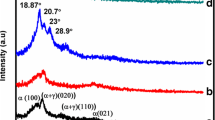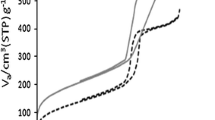Abstract
Mesoporous Santa Barbara Amorphous (SBA-15) was synthesized, and it was grafted with phosphonate functionality using a simple two-step process involving chloromethylation and subsequent phosphonation. The phosphonated SBA-15 (PSBA-15) was characterized using Fourier transform infra-red (FTIR) spectroscopy, solid-state 13C nuclear magnetic resonance (NMR), 29Si NMR, and 31P NMR for confirming successful modification. Morphology features were verified by small angle X-ray diffraction (XRD), scanning electron microscopy (SEM), and transmission electron microscopy TEM analyses. Poly(styrene-ethylene-butylene-styrene) (PSEBS) was chosen as the base polymer and phosphonic acid functional groups were grafted onto the polymer using the aforementioned approach, where chloromethyl (-CH2Cl) groups were attached to the main chain using Friedel Craft’s alkylation, followed by the phosphonation of the chloromethylated polymer by the Michaels-Arbuzov reaction resulting in phosphonated PSEBS (PPSEBS). The functionalization was confirmed using NMR and FTIR spectroscopy studies. Composite PPSEBS/PSBA-15 membranes were fabricated with different filler concentrations (2, 4, 6, and 8%) of PSBA-15. Various studies such as water uptake, ion exchange capacity, and the proton conductivity of the composite membranes were undertaken with respect to fuel cell applications. From the studies, it was found that the PPSEBS/PSBA-15 membrane with 6 wt% of filler exhibited maximum proton conductivity of 8.62 mS/cm at 140 °C. Finally, membrane electrode assembly (MEA) was fabricated using PPSEBS/6% PSBA composite membrane, platinium (Pt) anode, and Pt cathode, and was tested in an in-house built fuel cell setup. A maximum power density of 226 mW/cm2 and an open circuit voltage of 0.89 V were achieved at 140 °C under un-humidified condition.

Graphical abstract










Similar content being viewed by others
References
Chandan A, Hattenberger M, El-kharouf A, Du S, Dhir A, Self V (2013) High temperature (HT) polymer electrolyte membrane fuel cells (PEMFC) a review. J Power Sources 231:264–278
Zhang L, Chae S-R, Hendren Z, Park J-S, Wiesner MR (2012) Recent advances in proton exchange membranes for fuel cell applications. Chem Eng J 206:87–97
Zhengbang W, Haolin T, Mu P (2011) Self-assembly of durable Nafion / TiO 2 nanowire electrolyte membranes for elevated-temperature PEM fuel cells. J Membr Sci 369:250–257
Li Q, Jensen JO, Savinell RF, Bjerrum NJ (2009) High temperature proton exchange membranes based on polybenzimidazoles for fuel cells. Prog Polym Sci 34:449–477
Bose S, Kuila T, Nguyen TXH, Kim NH, Lau K, Lee JH (2011) Polymer membranes for high temperature proton exchange membrane fuel cell: recent advances and challenges. Prog Polym Sci 36:813–843
Nunes S, Ruffmann B, Rikowski E, Vetter S, Richau K (2002) Inorganic modification of proton conductive polymer membranes for direct methanol fuel cells. J Membr Sci 203:215–225
Jin Y, Qiao S, Zhang L, Xu ZP, Smart S, da Costa JCD, Lu GQ (2008) Novel Nafion composite membranes with mesoporous silica nanospheres as inorganic fillers. J Power Sources 185:664–669
Erog I (2009) Preparation and characterization of sulfonated polysulfone / titanium dioxide composite membranes for proton exchange membrane fuel cells. Int J Hydrogen Energy 34:3467–3475
Amjadi M, Rowshanzamir S, Peighambardoust SJ, Hosseini MG, Eikani MH (2010) Investigation of physical properties and cell performance of Nafion/TiO2 nanocomposite membranes for high temperature PEM fuel cells. Int J Hydrog Energy 35:9252–9260
Alberti G, Casciola M (2003) Composite membranes for medium temperature pem fuel cells. Annu Rev Mater Res 33:129–154
Yamada M, Honma I (2004) Anhydrous protonic conductivity of a Self-assembled acid - base composite material. J Phys Chem B 108:5522–5526, 18
Wu D, Xu T, Wu L, Wu Y (2009) Hybrid acid – base polymer membranes prepared for application in fuel cells. J Power Sources 186:286–292
Schuster M, Rager T, Noda A, Kreuer KD, Maier J (2005) About the choice of the protogenic group in PEM separator materials for intermediate temperature, low humidity operation: a critical comparison of sulfonic acid, phosphonic acid and imidazole functionalized model compounds. Fuel Cells 5:355–365
Lafitte B, Jannasch P (2007) On the prospects for Phosphonated polymers as proton-exchange fuel cell membranes. Adv Fuel Cells 1:119–185
Jun Y, Zarrin H, Fowler M, Chen Z (2011) Functionalized titania nanotube composite membranes for high temperature proton exchange membrane fuel cells. Int J Hydrog Energy 36:6073–6081
Nurhan U, Yagmur O, Yılser D (2017) Polybenzimidazole based nanocomposite membranes with enhanced proton conductivity for high temperature PEM fuel cells. Int J Hydrog Energy 42:2648–2657
Tripathi BP, Shahi VK (2011) Organic – inorganic nanocomposite polymer electrolyte membranes for fuel cell applications. Prog Polym Sci 36:945–979
Hong L, Oh S, Matsuda A, Lee C, Kim D (2011) Hydrophilic and mesoporous SiO 2 – TiO 2 – SO 3 H system for fuel cell membrane applications. Electro chimica Acta 56:3108–3114
Meenakshi S, Sahu AK, Bhat SD, Sridhar P, Pitchumani S, Shukla AK (2013) Mesostructured-aluminosilicate-Nafion hybrid membranes for direct methanol fuel cells. Electrochim Acta 89:35–44
Jiang SP (2014) Functionalized mesoporous structured inorganic materials as high temperature proton exchange membranes for fuel cells. Jour Mat Chem A 2:7637–7655
Park SJ, Lee DH, Kang YS (2010) High temperature proton exchange membranes based on triazoles attached onto SBA-15 type mesoporous silica. J Membr Sci 357:1–5
Wu J, Cui Z, Zhao C, Li H, Zhang Y, Fu T (2009) High proton conductive advanced hybrid membrane based on sulfonated Si-SBA-15. Int J Hydrog Energy 34:6740–6748
Won J, Lee H, Yoon K, Taik Y, Lee S (2012) Sulfonated SBA-15 mesoporous silica-incorporated sulfonated poly (phenylsulfone) composite membranes for low-humidity proton exchange membrane fuel cells : anomalous behavior of humidity-dependent proton conductivity. Int J Hydrog Energy 37:9202–9921
Jiang B, Haolin T, Mu P (2011) Well-ordered sulfonated silica electrolyte with high proton conductivity and enhanced selectivity at elevated temperature for DMFC. Intl J Hyd energy 37:4612–4618
Lafitte B, Jannasch P (2005) Phosphonation of polysulfones via lithiation and reaction with chlorophosphonic acid esters. J Polym Sci Part A Polym Chem 43:273–286
Allcock HR, Hofmann MA, Ambler CM, Morford R V (2012) Phenylphosphonic acid functionalized poly [aryloxyphosphazenes]. Macromolecules 35:3484–3489
Abu-thabit NY, Ali SA, Zaidi SMJ (2010) New highly phosphonated polysulfone membranes for PEM fuel cells. J Membr Sci 360:26–33
Parvole J, Jannasch P (2008) Poly(arylene ether sulfone)s with phosphonic acid and bis(phosphonic acid) on short alkyl side chains for proton-exchange membranes. J Mater Chem 18:5547–5556
Matsumura S, Hlil AR, Lepiller C, Gaudet J, Guay D, Shi Z (2008) Ionomers for proton exchange membrane fuel cells with sulfonic acid groups on the end-groups: novel branched poly(ether-ketone)s. Macromolecules 41:281–284
Wang Y, Zhu L, Guo B, Chen S, Wu W (2014) Mesoporous silica SBA-15 functionalized with phosphonate derivatives for uranium uptake. New J Chem 14:3853–3861
Vijayakumar E, Dharmalingam S (2015) A quaternized mesoporous silica/polysulfone composite membrane for an efficient alkaline fuel cell application. RSC Adv 5:42828–42835
Vijayakumar E, Raja A, Madhubala G, Dharmalingam S (2018) A synthesis study of phosphonated PSEBS for high temperature proton exchange membrane fuel cells. J Appl Polym Sci 135:45954–45959
Vijayakumar E, Dharmalingam S (2016) Synthesis characterization and performance evaluation of ionic liquid immobilized SBA-15 /quaternised polysulfone composite membrane for alkaline fuel cell. Microporous Mesoporous Mater 236:260–268
Vijayakumar E, Dharmalingam S (2018) Anion exchange composite membrane based on octa quaternary ammonium polyhedral oligomeric Silsesquioxane for alkaline fuel cells. J Power Sources 375:412–420
Srivastava R (2007) An efficient, eco-friendly process for aldol and Michael reactions of trimethylsilyl enolate over organic base-functionalized SBA-15 catalysts. J Mol Catal A Chem 264:146–152
Mistry B (2009) A handbook of spectroscopic data chemistry (UV, IR, PMR, 13CNMR and mass spectroscopy). Oxford Book Company, London
Chem JM, Chen S, Huang C, Yokoi T, Tang C, Huang S (2012) Synthesis and catalytic activity of amino-functionalized SBA-15 materials with controllable channel lengths and amino loadings. Mater Chem 22:2233–2243
Ran J, Wu L, Wei B, Chen Y, Xu T (2014) Simultaneous enhancements of conductivity and stability for anion exchange membranes (AEMs) through precise structure design. Sci Rep 4:6486–6491
Zhang B, Cao Y, Jiang S, Li Z, He G, Wu H (2016) Enhanced proton conductivity of Nafion nanohybrid membrane incorporated with phosphonic acid functionalized graphene oxide at elevated temperature and low humidity. J Membr Sci 518:243–253
Qian W, Shen C, Gao S, Xiang J (2017) Phosphonic acid functionalized siloxane crosslinked with 3-glycidoxyproyltrimethoxysilane grafted polybenzimidazole high temperature proton exchange membranes. J Appl Polym Sci 134:1–10
Jiang Z, Zheng X, Wu H, Wang J, Wang Y (2008) Proton conducting CS/P(AA-AMPS) membrane with reduced methanol permeability for DMFCs. J Power Sources 180:143–153
Funding
This work was financially supported by the Council of Scientific and Industrial Research (CSIR), New Delhi, India (Vide letter No. 01(2452)/11/EMR-11, letter dated 16.05.2011), Science and Engineering Board (SERB), New Delhi, India (Vide file No. EMR/2016/005615), and Center for Technology Development and Transfer (CTDT) Anna University.
Author information
Authors and Affiliations
Corresponding author
Additional information
Publisher’s note
Springer Nature remains neutral with regard to jurisdictional claims in published maps and institutional affiliations.
Rights and permissions
About this article
Cite this article
Elumalai, V., Rathinavel, S., Annapooranan, R. et al. Phosphonated mesoporous silica based composite membranes for high temperature proton exchange membrane fuel cells. J Solid State Electrochem 23, 1837–1850 (2019). https://doi.org/10.1007/s10008-019-04290-w
Received:
Revised:
Accepted:
Published:
Issue Date:
DOI: https://doi.org/10.1007/s10008-019-04290-w




